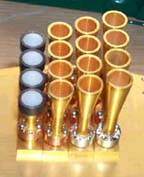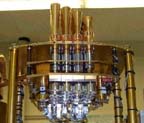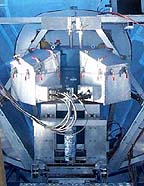
Figure 1: A micromesh spider-web bolometer produced by JPL

Figure 2: Top view of the ACBAR focal plane optics

Figure 3: Side/bottom view of the ACBAR focal plane optics

Figure 4: ACBAR (with electronics boxes) mounted on the Viper telescope
|
The ACBAR instrument is a cryogenically cooled bolometer array which simultaneously observes at four far-infrared frequencies (150, 220, 275, and 350 GHz). At the heart of ACBAR are extremely sensitive silicon-nitride micromesh bolometers fabricated by the Microdevices Laboratory at JPL. The bolometers are coupled to the telescope through corrugated feed optics which also contain the filter elements that determine the spectral bands (provided by
the Astronomical Instrumentation group at Cardiff University). The ACBAR dewar is a liquid nitrogen and helium cryostat and contains a three-stage 4He\3He\3He sorption fridge to cool the detectors to 230mK. ACBAR achieved a sensitivity to the CMB of ~370uK s^1/2 per 150GHz pixel in its inaugural year of observations. In the winter of 2001 the filtering was upgraded and achieved 240uK s^1/2 sensitivity per 150GHz pixel as well as exchanging the 350GHz detectors for another row of 150GHz. This will increase our mapping speed by a factor of four.
ACBAR observes from the 2m Viper telescope at the geographic South Pole. Viper is an off-axis gregorian telescope with a large field of view (50') and a chopping flat which can swing the beams ~3.5 degrees across the sky. ACBAR's beams from Viper are roughly matched at all frequencies with beam sizes of approximately 4'. Viper is enclosed in a reflective ground shield to reduce spill over contamination. The extreme cold at the pole reduces the water vapor content of the atmosphere resulting in excellent sky transmisson and minimal sky noise at mm wavelengths. The 24-hour darkness in the austral winter makes the atmosphere very stable for long periods of time as well as allowing observation of any portion of the southern sky.
ACBAR's ideal location, high sensitivity, and multifrequency coverage make it an ideal instrument for studying the physics of the universe through observations of the cosmic microwave background.
|